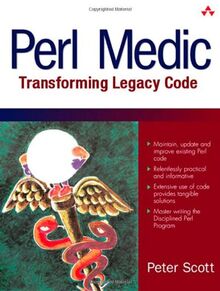The first book to explain how to understand, maintain, update, and improve existing Perl code
- Perl is especially susceptible to maintenance problems, because of its flexible style and ad hoc origins
- Author uses a medical theme throughout, playing off the similarities of doctoring or healing broken code
- Contains the most comprehensive treatment of testing Perl programs ever published, as well as the most comprehensive discussion of Perl version differences
This book is about taking over Perl code, whether written by someone else or by yourself at an earlier time. Developers regularly estimate that they spend 60 to 80 percent of their time working with existing code. Many problems of code inheritance are common to all languages, but the nature of the language makes Perl especially tricky. The reason why is that Perl is similar to English - bursting with irregular verbs, consistent only when it's convenient, borrowing terms from other languages, and providing many ways to say the same thing. In fact, Perl developers have a motto with the abbreviation TMTOWTDI: There's More Than One Way To Do It. While this flexibility is one of the language's strengths, it also makes it extremely difficult when you are faced with an existing piece of code. There are millions of lines of Perl code being used all over the Web; much of it was built on an ad hoc basis, the creators never imagining that the code would still be in use months or years later. This book will be the resource all Perl programmers need to understand someone else's code, even when it's bad; repair it; convert it to a better style; upgrade it to the latest version of Perl; maintain it; and find and fix its bugs.
